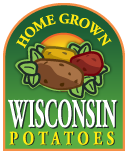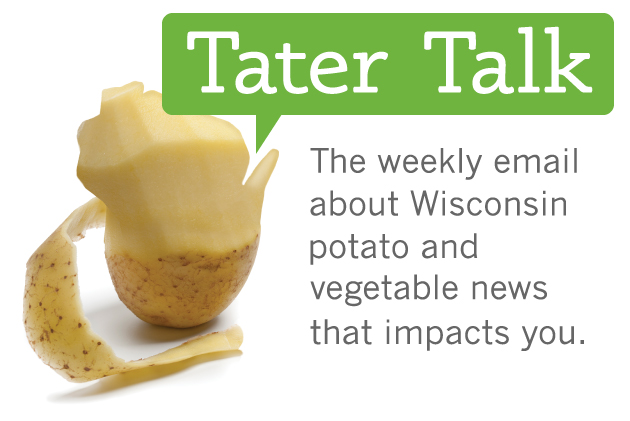As the Crow Flies
The Impact of Irrigation
By Ruth Faivre, Managing Editor

Ken Schroeder, Portage County UW Extension Agriculture Agent, explaines the county’s Ag economic impact to Portage County Board members.
Back in the day, before irrigation started in the 1950s, today’s lush Central Sands Region farm acres were nothing more than dry, dusty ‘prairies’ because the sandy soils could not retain moisture.
Area residents used to joke that, “When a crow flies over the region, it has to bring its own lunch.”
Now, a bird’s eye view would yield an entirely different story. Much of the sandy grasslands have given way to irrigated farm fields.
COMPOSITION
The Central Sands area lies east of the Wisconsin River and encompasses 1.75 million acres in parts of Adams, Marathon, Marquette, Portage, Shawano, Waupaca, Waushara and Wood counties. The area is defined by the Central Wisconsin Sand and Gravel Aquifer, deposits of sand and gravel that were left by melting glaciers at the end of the last ice age. The sand and gravel deposits form an aquifer that can store or transmit water underground.

Dairy remains a major Wisconsin industry, with growing strength in dried, condensed and evaporated milk and butter supplies. Dairy farming and dairy processing contribute 78,900 jobs, $3.9 billion to labor income, $7.2 billion to total income and $43.4 billion to industrial sales.
Due to the advent of irrigation, the Central Sands region is now an effective setting for a number of agricultural industries including dairy, vegetable produce, processing, grain, specialty crops, timber, Christmas tree and cranberry production. The estimated economic impact of irrigated agriculture in this area is over one billion dollars and thousands of jobs per year.1
Within this area, Portage, Waushara and Adams counties account for almost one-half of total agricultural irrigation. These counties also lead the state in the production of potatoes, sweet corn and other assorted vegetables .2
PORTAGE COUNTY
How does today’s agriculture specifically affect the economies in the counties of the Central Sands region and in particular, Portage County? Ken Schroeder, Portage County UW Extension Agriculture Agent, addressed that question for Portage County through a recent presentation made at a Portage County Board meeting.
According to Schroeder, 17% of Portage County’s economic activity ($1.17 billion) is generated by agriculture, which is about 17% of the county’s total economic activity. Plus, every dollar of sales from Ag products generates an additional $0.36 of economic activity in other parts of the county’s economy.
$795.6 million (68%) is directly from farm products while $150.0 million (13%) is generated by purchases of agricultural inputs and services (business-to-business purchases of fuel, fertilizers, feed, equipment, veterinary services and crop consultants).
Another $134.5 million (12%) originates from people working in agriculture-related businesses spending their earnings.
DAIRY’S ROLE
 Dairy reigns king in Portage County, too, since as Schroeder states, it provides, “$47.7 million, 13,500 cows, 268.6 million lbs. milk (31 million gallons) and 50,000 acres of forage crops.
Dairy reigns king in Portage County, too, since as Schroeder states, it provides, “$47.7 million, 13,500 cows, 268.6 million lbs. milk (31 million gallons) and 50,000 acres of forage crops.
VEGETABLE SIGNIFICANCE
Schroeder also explained that market value of vegetable crops in Portage County is $167.7 million, which represents 57% of total market value of all ag products sold in Portage County (2012 data).
Portage County is the #1 potato producer in the state with 848 million pounds on 17,600 acres. One acre produces an average of 48,000 lbs. and feeds 375 people for a year.
Over 72,000 acres are planted to vegetables, including potatoes, sweet corn, snap beans, peas, and specialty crops like beets, peppers, cabbages, cucumbers and more.
EMPLOYMENT

Portage County is the #1 producer of snap beans for processing in the state. WI is #1 producer in the nation (40% of U.S. market) with 3.4 ton/acre in 1977 and 5 ton/acre in 2007. (3)
As far as jobs goes, Schroeder asserted that “12.5% of Portage County’s workforce (total job number is 43,535), is employed in agriculture or agriculture-related jobs (5,448),” which he said includes farmers, employees, veterinarians, consultants, feed and fuel suppliers, food processors, machinery manufactures and dealers, building contractors and agriculture lenders.
PROCESSING’S CONTRIBUTIONS
Schroeder also distributed a UW Extension brochure that discussed how agricultural processing is the major agricultural industry in Portage County, contributing $669.2 million to the county’s economy.
$606.6 million of that total generates from Vegetable processing. The processing of milk into dairy products accounts for another $62.6 million.
Every dollar of sales of processed products in turn, initiates an additional $0.30 of economic activity in other parts of the economy.
Portage County’s agricultural processing businesses account for 2,611 jobs. Vegetable processing generates 2,442 jobs and Dairy processing brings in 169 jobs.
OTHER COUNTY IMPACT REPORTS
Steve Deller, University of Wisconsin-Madison professor of agricultural economics and University of Wisconsin-Extension community development specialist; and Dave Williams, University of Wisconsin-Extension associate professor and assistant program director for Agriculture and Natural Resources, measured agriculture’s contribution to the economy in each of Wisconsin’s counties. As the team finishes county reports from their research, they are posted on this web page:
anre.uwex.edu/economicimpact. Check your county or compare counties as you wish. This issue also includes an overview of Ag’s impact on Wisconsin, authored by Steve Deller.
SIGNIFICANCE
There is a sizeable compilation of knowledge regarding the status of the Central Sands’ lack of farming impact prior to irrigation in the 1950s as compared to the phenomenal growth after irrigation in the last six decades.
Therefore, it is not a stretch of imagination by any means to assume that if irrigation and high capacity wells were taken out of the equation in this region, economic growth would plummet drastically. Replacing the lost Ag dollars and jobs would become a void virtually impossible to fill.
PREMPTIVE PLANNING
A coalition of stakeholders from agriculture, business, government and organizations such as Wisconsin Potato & Vegetable Growers, Dairy Business Association, Wisconsin Manufacturers Council and others are working hard to develop strategies to achieve a sustainable balance between water uses.
This requires a scientific approach to adaptive management and utilizing intense mapping and modeling data that run the gamut of available scenarios in order to plot the best course for everyone’s future.
The coalition grows daily as more groups realize that this is a shared responsibility. The future belongs to those who can work together to chart a course towards new strategies that address situations while they can still be reversed, not after all hope is gone.
1 Wisconsin Dept. of Natural Resources. Central Wisconsin Sand and Gravel Aquifer Managing Water for Multiple Uses
2 Buchwald, C.A. 2009. Water Use in Wisconsin, 2005. U.S. Geological Survey, Open-File Report 2009–1076. Also, see reports for 1979, 1985, 1990, 1995 and 2000
3 2015 Portage County Agribusiness Impact County Board Report presented August 18, 2015
4 2014 UW Extension Portage County Agriculture: Value & Economic Impact Brochure





